91st Evacuation Hospital Unit History

An unidentified Nurse of the 91st Evacuation Hospital stands in front of the unit’s sign.
Early History & Activation:
Early history of the 91st Evacuation Hospital can be traced to the 6th Surgical Hospital, which was largely involved in actions in France during WW1. In preparation for WW2, the 6th Surgical Hospital was reactivated on 1 August 1940, at Fort Knox, Kentucky. The unit was scheduled to complete MTP training by 18 January 1941. Training facilities were adequate, but unit training in technical and tactical employment of the Surgical Hospital were delayed, as most of the organizational equipment needed to complete the training program had not been received. Difficulties in conducting classroom work in technical subjects was however completed on schedule, and further field training was undertaken. The unit established a large tented hospital at Fort Knox throughout the beginning of 1941.
The Office of the Surgeon General, following a report made in 1942, took the decision to re-designate a large number of the Surgical Hospitals as Evacuation Hospitals, in preparation for transfer to the numerous operational theaters. Slowly, the cadre of personnel belonging to the 6th Surgical Hospital was increased by Enlisted personnel from Indiana, Ohio and Kentucky to bring the unit up to complete T/O strength (T/O 8-580 dated 2 July 1942). The unit was officially re-designated as the 91st Evacuation Hospital on 31 August 1942, while the unit’s personnel were still located at Fort Knox, Kentucky.
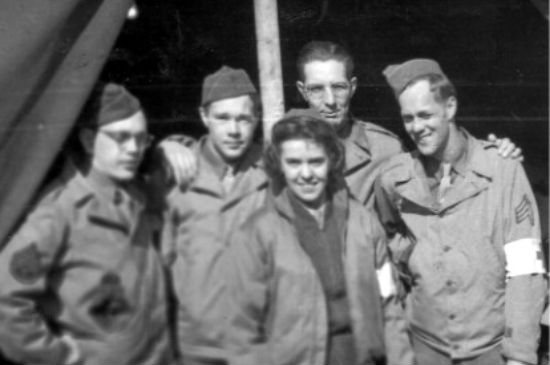
Members of the 91st Evac Hosp pose in front of a Large Wall Tent during a training exercise in the ZI.
After the training program had been completed, the Officers and Enlisted personnel departed for Camp Kilmer, Stelton, New Jersey (Staging Area for the New York P/E –ed), where they were joined by 48 Nurses to complete the unit’s total strength of 47 Officers, 52 Nurses and 318 Enlisted Personnel. By December the unit was fully prepared for shipment overseas, and Lieutenant Colonel Fred G. Lahourcade was appointed as the unit’s Commanding Officer. The unit set sail from the New York POE aboard the USS “Argentina” for Casablanca, French Morocco, on 12 December 1942.
French Morocco:
The unit arrived at its destination on Christmas Eve 1942, and upon debarkation was transported to a cow pasture approximately 3 miles from the port area. Here, the unit bivouacked for a considerable period until mid-January 1943. It should be noted that the 400-bed unit although in the area was not established under the Western Task Force control; it functioned as an independent fixed installation. During this time, the equipment required to establish a functioning Evacuation Hospital in the field was gradually arriving, and the unit’s motor pool slowly grew as more of its vehicles arrived.
On 31 December 1942, the unit experienced its first contact with the enemy, albeit indirectly. Many aircraft had been strafing the bivouac location for several days prior to New Year’s Eve, and then finally an aerial bombardment began at approximately 2000 hours. Luckily, no significant damage was caused to the newly arrived supplies and vehicles, and none of the unit’s personnel was severely injured.
Station at Port-Lyautey, French Morocco
91st Evacuation Hospital (400 beds, 2 February 1943 > 25 April 1943)
On 31 January 1943, the unit departed from its temporary location by rail for a new site approximately 90 miles away. Upon arrival at Port-Lyautey, French Morocco, the unit pitched the numerous ward tents to become the first hospital to be set up in the area. Additional space for wards and operating rooms was acquired by using wooden structures and abandoned buildings surrounding a cork forest. The vast majority of the tented area was used for staff quarters and post-operative wards, while the major surgical and medical wards were housed in the wooden buildings.
During its time at Port-Lyautey, the 91st Evacuation Hospital admitted a total of 1,335 patients (both surgical and medical) from 3 February 1943 until its date of closure at this location on 24 April 1943.
Algeria:
On 25 April 1943 (Easter Sunday), the unit received orders to move to a new location at Mostaganem, Algeria. Personnel gathered their belongings and then boarded 2 ½-ton trucks which formed part of a larger convoy to transport numerous units more than 500 miles to the new site. The unit departed early on the day, and as a result it was deemed that Easter services were unfeasible. Consequently, when the convoy camped that evening near to the town of Taza, the unit’s Chaplain presented an evening service to the personnel.
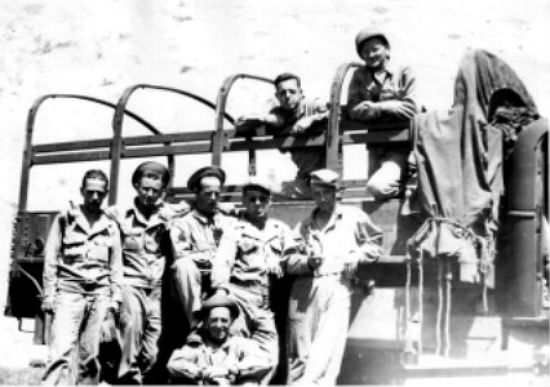
91st personnel pictured in front of one of the unit’s 2 ½-ton Trucks. Photograph taken during the organization’s time at Mostaganem.
The following day, the convoy arrived at Mostaganem and located its site. The area which had been chosen as the site for the Hospital was an abandoned (and slightly destroyed) racetrack. There was no space in the main complex for quarters, so a neighboring oat field was selected. The field was mown and numerous pyramidal and wall tents were erected for housing the personnel.
Station at Mostaganem, Algeria
91st Evacuation Hospital (400 beds, 2 May 1943 > 27 June 1943)
The personnel of the 91st Evac Hosp soon made good use of the remaining buildings at the racetrack. By 28 April 1943, the unit had established several wards in the partially destroyed buildings, utilizing both the grandstand and surrounding stables to its advantage. The set up was deemed to be extremely efficient, and no further changes or significant engineering works were needed in order for the unit to begin receiving patients. A steady stream of casualties arrived at the facility until 27 June 1943, when the hospital was officially closed. The unit once again went into bivouac and awaited further orders.
New orders were received and the unit once again boarded 2 ½-ton trucks for a five-day trip from Mostaganem to Bizerte, Tunisia. The numerous rest stops which were made on the way were a stark contrast to the conditions the personnel had been used to at Mostaganem. Nurses used two Army blankets to create latrine screens, while the Enlisted Men dug slit trenches and pitched individual shelter tents. At the same time, the unit’s equipment was being transported to the same location by rail.
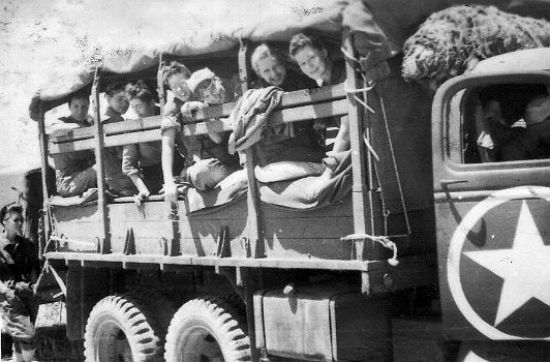
Personnel of the 91st Evac loaded into a 2 ½-ton Truck during the five-day trip from Mostaganem to Bizerte.
Sicily:
Transport by LST and motor convoy brought the 91st Evacuation Hospital into Palermo by 27 July 1943. An advance party of the unit had already begun work in converting two large buildings at the University of Palermo Medical School (the Polyclinic Hospital), which were to be used for the Hospital (it was later joined by the 59th Evacuation Hospital which landed on 6 August 1943, but was without equipment, still at sea). Italian PWs were also used as laborers around the site, and the process began with clearing great amounts of broken glass and debris from the recent aerial bombardments which had partially destroyed the buildings.
Station at Palermo, Sicily
91st Evacuation Hospital (400 beds, 27 July 1943 > 31 October 1943)
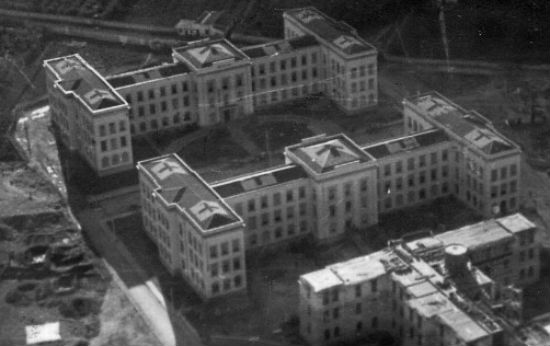
Aerial view of the hospital facility used by the unit at the University of Palermo Medical School. Photograph was taken by Major Sedam.
The Hospital slowly took shape, and the first patients at the facility were received on 29 July 1943. There was still a great amount of work to be carried out at the location, and indeed by this date not all of the unit’s personnel had arrived at the new site. With a limited number of surgeons available, Colonel Edgar Hyde, Lieutenant Colonel George Knapp and Captain Harry Meyer worked around the clock to handle the several admissions which were arriving at the site each day. Each surgeon slept for only a handful of hours in the first days at Palermo until the remainder of the Hospital’s staff joined the unit on 31 July.
Work continued on the facilities at the University, as the admission rate increased dramatically. It was not until mid-August that the patient census approached anything near to a manageable number for the Hospital’s size. In September, the necessary personnel and facilities were installed for prosthetic work, an activity taken over from the 1st Infantry Division Prosthetic Clinic. By the time the facility was closed on 31 October 1943, a total of 10,644 patients had been admitted to the 91st Evac Hosp since 29 July 1943.
England:
On 11 November 1943, the unit left the Mediterranean Theater for the E.T.O. and boarded the USS “Santa Rosa”, which landed at Swansea, Wales on 24 November. From the port at Swansea, the staff of the 91st Evac Hosp were transported by convoy to Bristol, where they remained for six months in preparation for the Invasion of Normandy.
A special program was developed to ensure that the unit could cope under pressure once in France. Tents would be repeatedly pitched and struck until the exercise was second-nature to the personnel, and done in the quickest time possible. The process was also repeated during hours of darkness. While not preparing for the Invasion proper or attending additional classroom lectures, all personnel of the unit were given temporary passes, and explored the sites of the English countryside.
On 1 April 1944, the unit was first alerted for a short sea voyage. At that time, the organization was located at Tortworth Court, Felfield, Gloucester. The area had been appointed as a “concentration area” in the build-up to Operation “Neptune”. During the following few weeks, the unit prepared for overseas movement, i.e., further training, packing and crating supplies, and obtaining individual and the remaining organizational supplies and equipment.
At 1230 hours on 3 June 1944, movement instructions were received by the Commanding Officer of the 91st Evacuation Hospital. The organization was to depart for its Marshalling Area at 1830 the same date. Organizational equipment and unit transportation departed on schedule for the Marshalling Area. The Movement Orders which had been received made no provision for the movement of the personnel consisting of 556 Officers, Nurses and Enlisted Men. Necessary action was instituted to correct the Movement Orders through the RTO at Bristol, to obtain necessary rail transportation for the balance of the organization. Final arrangements were completed, and the remainder of the organization entrained from the railway station at Tortworth on 5 June 1944.
France:
The organization departed from Camp Hursley (Marshalling Area) for the Embarkation Port (Southampton Port) on 8 June 1944, and boarded the SS “Thomas Wolfe”, a Liberty Ship. The unit’s supplies and equipment were loaded onto the vessel first, while its personnel waited on the docks. Loading of the ship, including all unit equipment and personnel was completed at 2000 hours on 8 June. The convoy to which the 91st Evac Hosp had been assigned set sail for the coast of France the following day. SS “Thomas Wolfe” was the flagship for the convoy of 30 ships, which sailed without escort to Normandy. There were no unusual incidents relative to the voyage.

Personnel of the 91st prepare for bivouac in Normandy. Photograph taken on 10 June 1944.
Whilst aboard the ship, the Commanding Officer received briefing instructions. The unit was to land at Utah Beach, in the vicinity of Saint-Martin-de-Varreville. The personnel disembarked over the side of the ship on rope ladders into LCIs at 1400 hours on 10 June 1944, and landed at Utah during the next half hour. All personnel had been successfully landed by 1500 hours. Once ashore, the personnel marched approximately 8 miles to Transit Area “A” (vicinity of Sainte-Marie-du-Mont –ed), where it bivouacked for the night.
A few Officers and the entire Transportation Section remained aboard the ship to unload the vehicles and equipment. Members of the Transportation Section operated the winches and cranes aboard the ship to unload the cargo of vehicles and equipment for the organization. Four 2 ½-ton 6×6 trucks and one ¾-ton weapon carrier were completely under water. The 6×6 trucks were recovered during the following 8 hours, while the ¾-ton weapon carrier remained in the Channel for approximately 36 hours before it could be recovered.
During the unloading of equipment, a reconnaissance party had located and staked out a potential Hospital site. This area was at Boutteville. The personnel were moved from Transit Area “A” to the new location on 11 June 1944. One by one as the vehicles came ashore and arrived at the area, they were unloaded and the Hospital erected. The majority of supplies and equipment arrived in good condition, however, the equipment on the five vehicles which had been immersed was saturated by sea water and could therefore not be of immediate use. The equipment was later dried, cleaned and put in usable condition. The weapon carrier carried the Hospital Headquarters. When it was recovered, all the records and files had floated from the vehicle and presumably were lost at sea. A thorough and constant search of the beach was made with hopes that some of the records would float ashore, but only a few minor files were recovered. A check was then made and it was determined that the following records and files had been lost:
Retained copies of Letters of Transmittal on Allotments
Service Records (WD AGO Form 24)
Enlisted Men’s Qualification Cards (WD AGO Form 20)
Officers’ Qualification Cards (WD AGO Form 66-1)
All Officers’ and Enlisted Men’s 201 Files
Special Orders (1940-1945 inclusive) of this Organization
All retained Copies of Extracts of S/R (WD AGO Form 25)
All Payroll and Voucher Records (except EM payroll for month of May 1944)
All retained Copies of Final Statements
All retained Copies of Morning Reports from 1 June to 31 December 1943
All file Copies of G-1 and G-3 Reports
All ‘secret’ and ‘confidential’ Orders and Memorandums
On 12 June 1944 at 0930 hours, the Hospital was opened and received its first patients. During the period of 12 June to 19 June, a total of 1,291 patients was admitted and cared for at this Hospital. The facility was closed on 26 June 1944 with a total of 2,142 admitted patients.
The following is a summary of the number and types of casualties treated at this Hospital during the period 12 June to 26 June 1944 (inclusive):
635 operative procedures were performed between 1200 hours, 12 June, and 2000 hours, 24 June 1944. The larger numbers were done prior to 20 June 1944. Operation of the Hospital began under the handicap of absence of its entire equipment and Officer personnel. Three Auxiliary Surgical Teams were used to good advantage, although they could not be obtained until twenty-four hours after request. One Team was especially secured for septic surgery.
Of great interest and worthy of consideration is the large number of major surgical procedures performed. The majority of the operations were on extremities. Abdominal, thoracic, neurosurgical and maxillo-facial surgical cases were more frequently administered than usual. Many of these cases were time consuming. Multiple injuries were in the majority.
Major Surgeries:
Abdominal Surgery: 34 operations were performed on the abdomen. The mortality rate was 26.8%. Many patients were in desperate straits. 7 of the 34 sustained injuries of the genito-urinary tract (kidney, urethra, bladder). There were 5 negative explorations (no serious injury to fiscus). All types of abdominal injury were found.
Thoracic Surgery: out of 215 cases of thoracic injuries treated, 97 were subjected to operation. 41 major operations of the chest were conducted. There were 13 thoracic-abdominal wounds. Two of the thoracic-abdominal wounds involved the kidney. The operative mortality was 5.2%. All deaths but one occurred in cases of thoracic-abdominal injury. There were 16 sucking wounds.
Surgery of the Eye, Ear, Nose and Throat and Maxillo-Facial injuries: there were a total of 34 such cases. Among these were 8 enucleations of the eye. There were 18 severe maxillo-facial injuries. 6 tracheotomies were done in this group. 2 deaths occurred among these 34 patients.
The total number of Neurosurgical Cases treated was 45. Of these, 36 were operated upon with no deaths. 11 were simple scalp lacerations. 25 craniotomies were performed; 5 were done for subdural hematomas, the others were for gutter type wounds; 3, compound fractures with no muscle; 8, penetrating wounds with missile in brain.
Extremity Surgery: the large number of extensive compound fractures encountered was of great interest. Out of 224 compounds fracture cases (exclusive of those of the vertebrae, skull and face) 42 were of the femur, 47 were of both bones of the lower leg, and 29 were of the humerus. Thus, 118 compound fracture cases required a considerable operative procedure including plaster encasement. A total of 31 amputations of the extremities were performed: 8 were amputations of some part of the hand or fingers; 6 thigh amputations; 9 leg amputations; 2 foot amputations; 5 arm amputations; and 1 forearm amputation were done. A large number of these could more rightly be classified as completion of traumatic amputation. 20 were performed in gas-gangrene cases.
Shock therapy: usually the supply of type 4 blood form the Blood Bank was good. On 2 occasions, the staff resorted to bleeding its own personnel. The first blood bottle drips were very poor. The small delivery of blood to the patient and frequent clogging was very discouraging. The staff resorted to open Salversen tubes and Vacoliter bottles.
There were only 3 burn cases, one was multiple phosphorous burns, 2 were first and second degree burns of hands and face respectively. Out of the 635 operations performed, a conservative estimate would classify 267 or 42% as major operations requiring more than one hour for their completion. These include abdominal operations: 34; major chest operations: 41; severe maxillo-facial injuries: 18; craniotomies: 25; and major extremities 149. Of the neuropyschiatric cases admitted during the month, the majority was of the combat exhaustion type. The few more serious cases were transferred to the 622d Medical Clearing Company which was acting as a NP Hospital.
As of 19 June 1944, the hospital was officially closed at Boutteville, but continued care of those patients who were non-transportable. A new Executive Officer was also assigned; Lieutenant Colonel Thomas T. Beeler, MC, relieving Lieutenant Colonel George M. Knapp, who was transferred to XIX Corps.
On 28 June the organization moved to Pont-l’Abbé, except for a rear Detachment to care for the few remaining non-transportable patients. It was in this new location that Colonel Paul Hayes was assigned as the new C.O. to replace Lieutent Colonel Fred G. Lahourcade, who had been transferred to the 42d Field Hospital. Thus, in the short space of 9 days, the two top command positions were changed.
The Hospital officially opened at Pont-l’Abbé on 3 July 1944, and remained in operation for 15 days. During that period, 2,549 actual admissions and 151 administrative admissions were recorded (a total of 2,700). During the unit’s time at Pont-l’Abbé, the 91st Medical Gas Treatment Battalion was attached and provided an additional 150 beds for the less seriously injured patients. Upon closing, all patients were transferred to the 104th Evacuation Hospital which relieved the organization. Most of the tentage which was still pitched at the location was exchanged with this unit to expedite the transition.
On 20 July 1944, the 91st Evac moved to La Cambe, France for a rest period. After a few days rest, the organization moved once again on 31 July to Marigny, opening at 1800 the same day. A total of 1,202 admissions were recorded until 7 August 1944 when the complex was officially closed. Only 17 deaths occurred, causing a sharp decline in the overall mortality rate.
By 9 August 1944, the unit was on the move once again, this time to Brécey, France. Upon arrival at the location the same date, it opened at 1800. This location was by far the most suitable bivouac area, being high on a plateau overlooking a beautiful valley. In 12 days of operation, 1,350 patients were admitted, 26 of which died. The front was moving fast and the unit now found itself far to the rear. During the unit’s stay at Brécey, it cared for French civilians. One French woman was admitted who, shortly after admission, gave birth to a baby. The following statistics show the admission status of the 91st Evacuation Hospital until August 1944:
| Number | Died | Percent | |
| Patients admitted to the Hospital | 5,917 | 121 | 2.04 |
| Patients dead on arrival | 19 | ||
| Patients operated upon in Hospital | 3,839 | 68 | 1.77 |
| Patients died without operation | 44 | 0.76 |
On 28 August 1944 the unit departed for its new location; Guyancourt (in the Ile-de-France region, near to Versailles), stopping overnight at Senonches. Despite the inclement weather, the Hospital was ready to function and officially opened at 1200 on 30 August 1944. From this time to 7 September, 816 patients were admitted and 13 deaths occurred. Most of those expiring were enemy patients. By 20 September 1944, all patients were transferred or returned to duty to their organization. A number of the 91st staff were hospitalized, suffering from respiratory diseases due to climatic conditions.
The unit remained in bivouac until 27 September when it moved to Marle, France for an overnight bivouac en route to its new destination: Holland. The following is a summary of the admissions made to the 91st Evacuation Hospital during its time in France:
| Number | Died | Percent | |
| Patients admitted to the Hospital | 816 | 9 | 1.1 |
| Patients dead on arrival | 4 | 0.49 | |
| Patients operated upon in Hospital | 340 | 5 | 1.47 |
| Patients died without operation | 4 | 0.49 |
The organization was entitled to battle participation credit for the Normandy Campaign per paragraph 1, Letter HQ ETOUSA, AG 200.6 OpGA, subject: “Battle Participation Awards – Normandy Campaign (No 1)”, dated 16 November 1944. This was the second battle participation honor earned by the unit during World War II.
Holland:
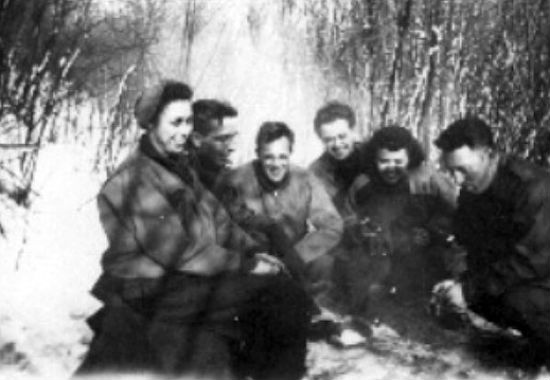
Personnel of the 91st enjoy a picnic in the woods surrounding Valkenburg during the unit’s time in the location.
On 27 September 1944, the unit departed France for its new location at Valkenburg, Holland. The Hospital was to be established in a Rijksschool, a building which was provided with both electricity and running water; both a commodity to the personnel of the 91st by now! After a thorough survey of the building, the Hospital Plan was decided upon and all hands went to work removing furniture etc. from the rooms designated to become wards. In a very short space of time, the building was thoroughly ready for operation as a hospital. The Hospital itself was set up on the ground floor of the building, with the second story being used for Officers’ and Nurses’ quarters. Enlisted Men were quartered on the second floor.
The first patients were received on 1 October 1944. Average admissions early in October totaled 175 daily. Towards the close of the month, average admissions dropped to 75. However, for the entire month a total of 3,973 patients were admitted to the facility.
As of 22 October 1944, the unit was relieved from assignment to the First United States Army and re-assigned to the Ninth U.S Army, by order of the Twelfth Army Group Commander.
The drive on Germany began its full swing on 16 November 1944. The Hospital, situated close to the front lines had its largest turnover of patients the following day, with 414 admissions and 397 dispositions. This was indeed quite a record for a Hospital of this size. Subsequent days provided no let-down in turnover except for a very slight decrease. As of 16 November (which marked 47 days of operation in this area) a total of 7,407 patients were treated. On 24 November 1944, additional patients were received from the 15th General Hospital, which had been hit by a V-1 rocket at Liège, Belgium.
The New Year brought a decrease in the number of admissions as the front moved further away from the Hospital’s location, and during the entire month of January 1945, the patient’s census was relatively low with a total of 971 admissions having been recorded. A large number of these admissions were on the medical service. The 10-day evacuation had been extended and the unit was therefore able to return more patients direct to duty than in any other period.
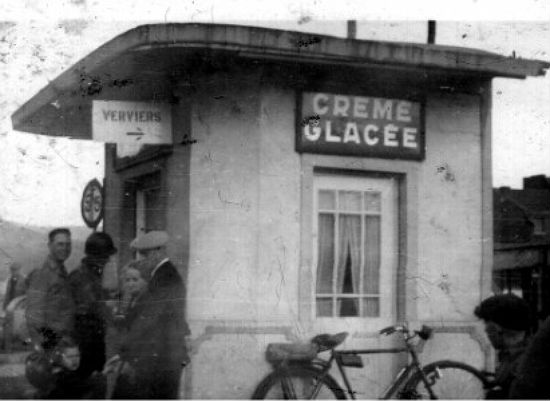
View of an ice cream stand located in Liège. Members of the 91st Evac Hosp mingle with local civilians and enjoy a treat!
On 23 January 1945, the organization was notified by the 62d General Hospital (located close to Paris) that Tec 3 Frederick A. Koss (ASN:35501204), a member of the 91st Evacuation Hospital who had been hospitalized at the 62d Gen Hosp, had passed away on 17 January 1945. This news was received with great sorrow by all the staff at the 91st. This was the second death of organizational personnel since it departed from the United States, neither being a battle casualty.
In early February, all attached Surgical Teams were withdrawn except one, and on 23 February 1945, the influx of battle casualties topped those on the medical service for the first time in considerable time. The Ninth U.S. Army was now on the move to the Rhine. 206 patients were admitted, with 162 being evacuated on 23 February 1945.
Germany:
By early March, the 91st had crossed the border and entered into Germany, in an effort to remain as close to the front line as possible. The unit set up in the countryside outside the town of Hostert, Germany, on 8 March 1945. 13 days later the unit once again packed up and prepared to cross the Rhine. On 28 March 1945, the 91st Evacuation Hospital became the FIRST unit of its type to have crossed the Rhine River.
Having crossed the river, the unit was set up in tents near to Friedrichsfeld. The unit saw a steady flow of admissions during this period. By April 1945 the unit had once again moved station to a number of locations, eventually settling in an unlikely venue – a health resort and spa at Bad Salzuflen (thermal resort in North Rhine-Wesphalia –ed). Here the Hospital cared for 771 patients before moving again on 14 April 1945, this time, to an open field near Wiepke, Germany.
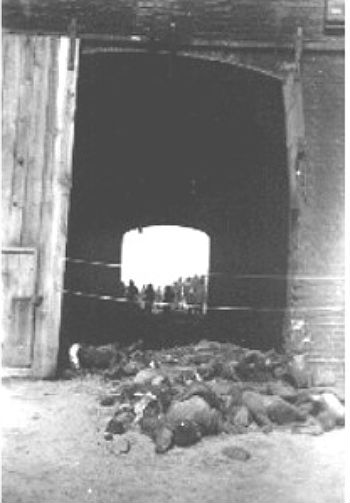
View showing some of the charred remains of the 1,016 human beings (mostly Polish and Russian slave laborers) who had been burned alive in a large barn situated at Gardelegen.
While stationed at Wiepke (near the town of Gardelegen), members of the 91st Evacuation Hospital discovered a hay barn, made of brick with wide wooden doors at either end. On 18 April 1945, the personnel discovered a mass grave inside, within which lay the evidence of Nazi atrocity – the charred remains of 1,016 human beings who had been burned alive by the retreating German forces (please see our Unit History of the 53d Field Hospital –ed).
The End:
The unit was located in Wiepke when it received news of VE-Day on 8 May 1945. Shortly after that date, the Hospital staff went into bivouac at Wolfenbuttel, Germany. Colonel P. Hayes was relieved of his position as Commanding Officer at the end of June 1945, and transferred to the 191st General Hospital in Paris. During his service with the 91st, Colonel P. Hayes was awarded the Bronze Star for his outstanding services on 23 January 1945 by the Surgeon, Ninth U.S. Army.
Speculation that the unit would now be heading to the Pacific Theater was rife, but proved unfounded on 2 September 1945 when the Japanese unconditional surrender was announced. The personnel of the unit were then transferred to France, and returned to the ZI.
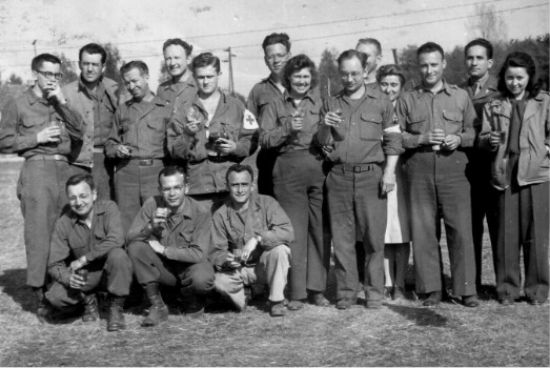
Photograph of 91st Evacuation Hospital personnel taken on V-E Day during the unit’s time at Wiepke. Photograph taken by
Sgt Habich.
The authors would like to thank Deborah Ann Taylor who maintains a website dedicated to the 91st Evacuation Hospital. A number of the illustrations used in this Unit History have been borrowed from her website, for which the authors are truly grateful. Please visit the site for more information. We are still looking for some data relating to the organization’s late war years and inactivation.
